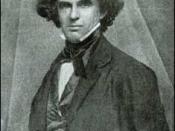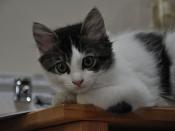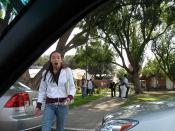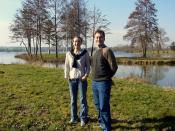Kressl
Mrs. Eisenberg
English 285
March 24, 2009
The Perversion of Nature
Ancient days were hazy. Not much was known about the world. Science was still young and the universe so mysterious. All natural occurrences were attributed to some sort of Supernatural force and all human endeavors were to be acted through this force. There was the acceptance of man's limits and capabilities; the unhumble craving to eat from the Tree of Knowledge was not yet developed.
Yet, as time passed, and a certain few dedicated towards the science toiled, technology increased. What was first thought to be impossible suddenly was a reality. Everything was now explained in Natural terms and the world became rational and logical on its own terms. Gone went any need for the Supernatural, and forgotten were the human's limits.
The human could achieve anything, create anything, and discover anything with his intelligence, time, effort, and sacrifice.
With this confidence, exponentially were things being achieved, created, and discovered, which did no more but add credence to the new scientific province. This was beneficial to society as the science was concentrated on applied science that was meant to enhance and better the lives of people, animals, and land.
An unwanted byproduct did emerge, though, as the uncontrolled ego of the intellectual and ever more powerful scientist began to inflate. The power and sense of control began to direct their minds, personalities, and methods, as Nature was becoming an exhausted force that could be purged and abused as it served their domination. Everything was created by Nature as imperfect and defective and was to be manipulated and reformed by the hands of the cold scientist. Science was no longer the study of Nature but rather the manipulation of Nature.
Nathaniel Hawthorne was born on July 4, 1804, just one year after the Louisiana Purchase. He grew up with the American people wary of its virtues-was this expansion for the people's benefit, or just to add to the country's power? His childhood was then defined with the revolution of 1800, with extraordinary changes in the political, geographical, and technological fields. The conflict between exploring the unknown and imposing control on society led to redefinition of human rights, human Nature, limits, power, and obligation.
In response to this Age of Enlightenment, the Romantic Movement arose, stressing American themes and acknowledging the importance of emotional influences over reason and science. Hawthorne wrote "Rappaccini's Daughter" to illustrate his view of how the worship of science and physicality would prove injurious to American society.
Giovanni Guasconti is depicted as a shallow and vain man, yet also as a romantic. He views Nature as a force that is beautiful in it of itself-he is repulsed by the idea of Giacomo Rappaccini's predilection in manipulating it. He viewed the garden's artificialness as the "adultery of various vegetable speciesâ¦no longer God's making, but the monstrous offspring of man's depraved fancy, glowing with only an evil mockery of beauty (Hawthorne, 9)." Giovanni only beholds as beautiful what is natural and untainted by man.
Giovanni finds the disunity with Nature intrinsically unsatisfactory. Even before he knows of Rappaccini's usage of Beatrice in experimentation, he "thinks he is an awful man, indeed (Hawthorne, 4)." This explains why he is so attracted to Beatrice besides for her external beauty. Giovanni frowns as Rappaccini refuses to touch the plants with his bare hands and "approach intimacy between himself and these vegetable existences (Hawthorne, 2)." In contrast, Giovanni marvels when Beatrice reveals herself and instantly connects and intimates herself with all the garden's flowers, as if she were a sister to these "vegetable existences." Giovanni respects a communion with nature rather than a manipulation of it.
Pietro Baglioni also disapproves of this controlling attitude towards Nature, even before he is aware of Rappaccini's doing with Beatrice. Baglioni is "of genial Nature, and habits that might almost be called jovial (Hawthorne, 3)," and much less intense than Rappaccini as he was apt to drink wine and make merry. It is not a dispute, however, in personalities and attitudes that causes Baglioni's detestation of Rappaccini, it is rather common professional jealousy.
Rappaccini though is not concerned with the mundane jealousy; rather he concerns himself with accumulating more and more knowledge. He does not care for relations with people or anything beyond the realm of his science. His patients are treated only as means to experiment, the cures only as physical manifestations of his knowledge.
Rappaccini, though, is not meant to be perceived as evil, rather just a cold and heartless intellect who is out of touch with common human values and feelings. He does not use his powers to harm anyone intentionally; he just does not care if they do by default of an experiment. Rappaccini is not concerned with the beauty and sanctity of Nature, he only cares for the science of it. So while Giovanni looks at the garden as a mockery of beauty, mockery was not the intent of its creator. He wanted the poisons, and that they happened to be beautiful was not of importance to him. Certainly, to his credit, there is also the fact, that though, he is unkind, he is efficacious at healing people, as he proves to be able to concoct marvelous cures.
Rappaccini does not mean to harm his daughter when he imposes a poisonous lifestyle on her. The "garden is his world (Hawthorne, 9)" and he just wanted Beatrice to be able to live the invulnerable and all-powerful life he himself craved. He was so twisted and out-of-touch that he could not comprehend when Beatrice "would fain have been loved, not feared (Hawthorne, 17)." His decision then to render Giovanni also poisonous was not out of malice, but rather out of sympathy for Beatrice's loneliness.
Hawthorne may have learned some of these elements from Shelley's Frankenstein, which was published only twenty years before "Rappaccini's Daughter." Dr, Frankenstein, not out of cruelty, merely zeal of science, created a being shunned by all and capable of immense devastation. Then tempted by mercy to create a mate for the monster, he grapples in the domain of scientific immorality. This can be made parallel to Rappaccini's creation of Beatrice, a girl who is to be avoided by all humans because of her fatal capabilities, and out of mercy Rappaccini then gives into the temptation to create a mate for her. They differ, though, as Frankenstein's conscience is obviously much more prominent in his life than Rappaccini's is.
Hawthorne makes clear though that it is not only the cold science that is dangerous, for Baglioni emerges as the cruelest villain of the story. He is the one who gives the antidote to Giovanni to administer to Beatrice. His audacity then is revealed when Beatrice is lying perished and Giovanni and Rappaccini are standing there in grief and somber, Baglioni calls out in mockery and with laughter, "Rappaccini! Rapaccini! And is this the upshot of your experiment? (Hawthorne, 17)"
Giovanni, the shallow and flaky romanticist, falls prey to the lure of science. He is constantly deliberating whether his Beatrice is "beautifulâ¦or inexpressibly terrible (Hawthorne, 5)." He never shows any faithfulness or sincerity of heart, and persistently cannot see past Beatrice's poisonous curse and see her beautiful spirit.
Beatrice is cast as the ideal character. She is the opposite of science, both Rappaccini's and Baglioni's kind. She is a "heavenly angel," though is a victim to have to bear a poisonous nature. She dreams of love and human touch and has so much capacity for it, save for her fatality. Where Giovanni is constantly doubting Beatrice's character, the one instant that Beatrice doubts him "made her blush that she had doubted him for an instant (Hawthorne, 15)."
There is no mistaking the comparison between Dante's and Hawthorne's Beatrices. Dante describes Beatrice as a girl "who brought bliss to all who looked upon herâ¦the bringer of blessings (Dante, 47)." She was the model of virtue and courtesy, a gift from God to enrich and enhance all those who appreciate her qualities. Hawthorne's Beatrice had the same spirit, yet her faithful and loving character is imprisoned by the "man's ingenuity and of thwarted Nature, and of the fatality that attends all such efforts of perverted wisdom (Hawthorne, 17)."
Hawthorne's message rang loud in 1844, yet is still heard today. When humans lose touch with our basic human values and emotions, there is nothing to keep our greed in check. Man has to remember that the purpose of science is to help and enhance the world, not aggravate it.
Works Cited
Alighieri, Dante. Inferno-The Divine Comedy of Dante Alighieri. New York: Oxford University Press, 1996.
Bloom, Harold. Bloom's Biocritiques-Nathaniel Hawthorne. Philadelphia: Chelsea House Publishers, 2003.
Dante Alighieri, Mark Musa. The Portable Dante. New York: Penguin Books, 1995.
Martin, Terrence. Nathaniel Hawthorne. Boston: Thwayne Publishers, 1965.
Mellow, Jane R. Nathaniel Hawthorne in His Times. Boston: Houghton Mifflin Company, 1980.
Wineapple, Brenda. Hawthorne: A Life. New York: Alfred A. Knopf, 2003.





![[Piazza di San Giovanni in Laterano, Rome, Italy] (LOC)](https://s.writework.com/uploads/8/89974/piazza-di-san-giovanni-laterano-rome-italy-loc-thumb.jpg)